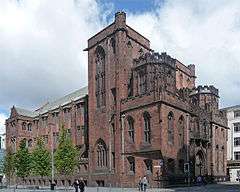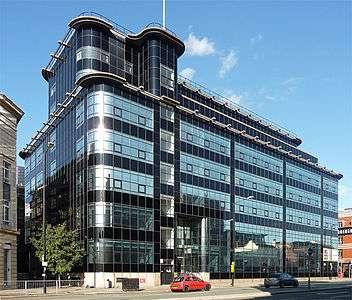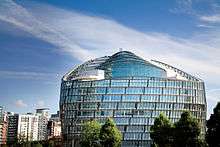Manchester Athenaeum

The Athenaeum in Princess Street Manchester, England, now part of Manchester Art Gallery, was originally a club built for the Manchester Athenaeum, a society for the "advancement and diffusion of knowledge" in 1837. The society, founded in 1835, met in the adjacent Royal Manchester Institution until funds had been raised for the building which had a newsroom on the ground floor, library, lecture hall and coffee room. The members later added a billiard room and gymnasium. It survived financial difficulties to become the centre for Manchester's literary life.[1] Sir Charles Barry, who designed the Royal Manchester Institution in the Greek Revival style, designed the Athenaeum in the Italian palazzo style, the first such building in the city. Manchester Corporation acquired the building in 1938.[2] In 2002, Manchester Art Gallery was extended by Hopkins Architects following an architectural design competition managed by RIBA Competitions to take in the Athenaeum.[3] It is linked to the art gallery by a glass atrium.[4] The Athenaeum is a grade II* listed building.[5]
Richard Cobden was instrumental in promoting education in the city and spoke at the opening and within four years it had over 1,000 members. Charles Dickens and Benjamin Disraeli addressed its membership in the 1840s. The club declined after 1935.[6]
Architecture
The building is constructed of sandstone ashlar under a slate roof on a rectangular plan and originally had two storeys and a basement. It has a symmetrical nine-window facade with raised rusticated quoins at the corners and an inscribed frieze under a prominent mutuled cornice. The inscriptions on the frieze are, "INSTUTVTED MDCCCXXXV ATHENAEUM ERECTED MDCCCXXXVIII" and "FOR THE ADVANCEMENT AND DIFFVSION OF KNOWLEDGE". The building's interior was damaged by fire in 1874 and was remodelled and an attic floor was added behind a high balustraded parapet with four tall chimneys.[5]
A central entrance porch with a coffered barrel-vaulted ceiling is accessed by a flight of stone steps and has Doric columns supporting a frieze, moulded cornice and balustraded parapet. The first and second floors have tall two-light casement windows with architraves, balustrades and pediments to the second floor.[5]
References
Notes
- ↑ The Athenaeum, Princess Street, Manchester, Greater Manchester, English Heritage, retrieved 1 May 2012
- ↑ Hartwell 2001, p. 90
- ↑ Manchester Art Gallery, Royal Institute of British Architects, retrieved 1 May 2012
- ↑ Manchester Art Gallery Case Study (pdf), Royal Institute of British Architects, retrieved 2 May 2012
- 1 2 3 Historic England, "The Athenaeum 81 Princess Street (1270889)", National Heritage List for England, retrieved 1 May 2012
- ↑ Frangopulo 1997, p. 104
Bibliography
- Hartwell, Clare (2002), Manchester, Pevsner Architectural Guides, Yale University Press, ISBN 0-300-09666-6
- Frangopulo, Nicholas Joseph (1977), Tradition in action: the historical evolution of the Greater Manchester County, EP Publishing, ISBN 0-7158-1203-3
Coordinates: 53°28′43″N 2°14′29″W / 53.47861°N 2.24139°W




